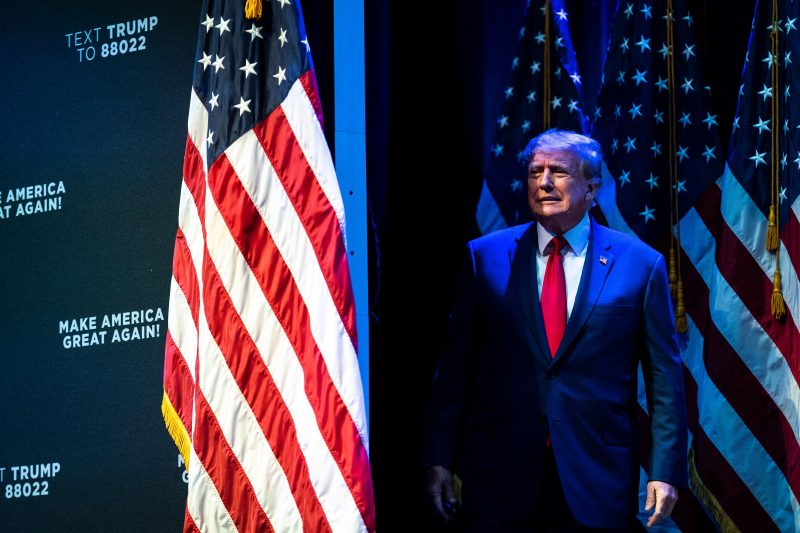
Trump’s brute-force strategy to make his indictment threat universal
One of Donald Trump’s less-appreciated political skills is getting his supporters to view attacks on him as attacks on them. His supporters have often seen him that way, viewing criticism of Trump’s presidency or of him personally as an attack on the political movement he leads and, therefore, on them. The tactic works.
Or: It generally does. When Trump’s primary frustration was the investigation into Russia’s interference in the 2016 election and possible overlap between that effort and his campaign, turning the probe into a perceived attack on his supporters was tricky. Sure, there was a lot of “the Deep State is out of control and could do this to you,” but it’s not clear that this really landed. Instead of building his base’s reserves of empathy, the Russia probe drew from them. Instead of Trump making everyone the victim, he mostly fell back on complaining about being a victim himself.
Since he lost the 2020 election, though, he’s had better luck. That’s particularly true of the probes underway in New York and Georgia, where he has opted to point at a potent worry for his base: reverse racism.
Over the weekend, Trump declared on social media that he expected to be indicted this week by a grand jury empaneled by Manhattan District Attorney Alvin Bragg. He’s been attacking Bragg for some time now, but the idea that things were coming to a head triggered a new round of scattershot protests from the former president.
At the platform he helped launch, Trump posted a lengthy, all-caps attack on Bragg, accusing the D.A. of letting murderers “walk free” and insisting that Bragg had “presided over the biggest violent crime wave” in the city’s history, which is not even close to true. But he led with his core frustration: that Bragg is a “racist, [George] Soros backed D.A.”
This “Soros-backed” claim is not a new one from Trump or others on the right. Soros, a left-wing philanthropist, is a frequent target of the right in part because of his willingness to spend to influence politics and, in some quarters, because he is Jewish. The link to Bragg is by no means direct: Soros has backed a nonprofit called Color of Change that includes a political action committee committed to electing Black candidates. Bragg, who is Black, received the group’s backing.
Bragg being Black is also why Trump accuses him of being “racist.” Trump has done this before; he has accused New York Attorney General Letitia James of being racist, as well as Fulton County, Ga., District Attorney Fani Willis. The two characteristics all of those prosecutors have in common are that they are Black and are involved in investigations into Trump.
Now we lumber into familiar territory when we’re talking about Trump. Does he actually think they are racist against him, echoing concerns about discrimination against Whites that is common among White Republicans, or is he simply being opportunistic? The answer, as it usually is, is that it’s probably a mix of both. Trump is both a driver and consumer of right-wing rhetoric, and it’s hard to disentangle what he believes from what he believes to be useful.
The effect is the same. Trump is not simply hoping that his supporters view him as a victim of an overzealous prosecutorial effort, as he hoped they might during the Russia travails. He is, instead, amplifying the idea that these Black prosecutors are coming after him because he’s White. While most Trump supporters were not likely to face a probe by the FBI’s counterintelligence infrastructure, most are White. And many of them think that Whites are targets of discrimination as often as Black or Hispanic Americans.
For years, conservative media has been rife with stories about how White Americans are disadvantaged relative to non-Whites, an exemplar of the form of political judo that tries to turn a weakness into a strength. Here’s Trump indicating to his heavily White often upper-middle-class supporters that Black officials might be targeting him just because he is also White. He’s turning fears of “reverse racism” into an empathy engine.
This isn’t his only tactic, certainly. In another all-caps post on social media, Trump suggested that this wasn’t just Black people unfairly attacking a White person but leftists attacking the right.
“Remember, the same animals and thugs that would do this to perhaps 200 million people,” he wrote, “but actually all Americans, are the communists, Marxists, RINOs [Republicans in name only], and losers that are purposefully destroying our country!”
All of the left is trying to undermine everyone on the right. Black officials are trying to take down White Americans. So what are his supporters to do?
“It’s time!!!” he wrote in another post. “ … They’re killing our nation as we sit back & watch. We must save America! Protest, protest, protest!!!”
All of this sounds disconcertingly like the period between the 2020 election and Jan. 6, 2021. Then, too, Trump cast his efforts to retain power as a rejection of a powerful left-wing establishment that wanted to muffle his base.
“We’re all victims,” he told the audience at a December 2020 rally before the Georgia runoff Senate elections that were held on Jan. 5, 2021. “Everybody here, all these thousands of people here tonight, they’re all victims, every one of you.” Less than two weeks later, he was encouraging supporters to travel to Washington on the day that evolved into the Capitol riot, telling them that there would be a “[b]ig protest in D.C. on January 6th. Be there, will be wild!”
People showed up. At his rally near the White House that morning, Trump repeated his argument that they were all victims.
“It almost seems that they’re all going out of their way to hurt all of us and to hurt our country,” he said.
You know what happened next.
